News
Sajith defends progressive taxation, highlights inequality
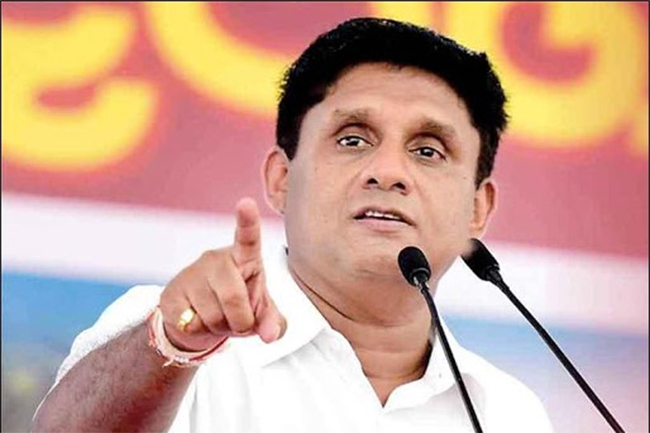
ECONOMYNEXT –Days after he lambasted the government for its tax policy, Sri Lanka opposition leader Sajith Premadasa defended progressive taxation noting a serious income inequality in the crisis-hit South Asian nation.In a meeting held in Kandy with the city’s business community, Premadasa said the main opposition Samagi Jana Balawegaya (SJB) has a team of politicians who are experts on economic policy formulation.
“There is serious imbalance (inequality) in our country. Eighty percent of our tax revenue is from indirect taxes. The remaining 20 percent is through progressive taxation where the tax paid increases as income rises,” said Premadasa.
Progressive taxation is fair and equitable, he said.
“What we first need to do is correct this imbalance. We have practical economists with us. There needs to be politicians who understand monetary policy, tax policy and all national policies. The politician cannot be subservient to the advice of officials alone.
“Our political team is one that possesses great knowledge of economic policy,” he added.Speaking at an election rally in Thambuttegama on February 12, the SJB leader criticised the government for its income tax hike.
“The ali pohottu kaputu government is burdening the people with taxes. We hear they’re planning to impose a tax on people who earn 45,000 rupees a month too. Just great,” said Premadasa addressing a large crowd of SJB supporters.
Premadasa was likely referring to reports that the International Monetary Fund (IMF) had asked the government to impose taxes on anyone who earns above 41,667 rupees a month as a condition for a 2.9 billion US dollar extended fund facility. However, the tax threshold remains at 100,000 rupees a month and there is no indication yet that it will be lowered.At an economic summit organised by the SJB in Colombo on February 14, SJB legislator Harsha de Silva presented the party’s proposals for tax reform under an SJB government.
The MP said the party supports progressive tax and that the highest earners should even pay as 39 percent if not more. He also took a swipe at rival opposition group the National People’s Power (NPP) which recently proposed that the tax threshold be increased to 200,000 rupees a month and the highest tax rate be capped at 24 percent.
The SJB’s Economic Blueprint acknowledges that the government has conducted tax reforms, but in its implementation has imposed too high a burden on Sri Lanka’s middle class, disincentiviseing exporters.
The document noted: Both personal and corporate income taxes have been revised. Personal income tax threshold and slabs were reduced, and marginal tax rates revised upwards. The VAT rate was increased, and the threshold was revised downwards, helping expand the tax net.
However, the revised personal and corporate income tax rates are much higher than in the 2017 Inland Revenue Act. The significant increase in personal income tax via PAYE during high inflation has imposed significant burdens on most professional groups. Tax slabs should be broadened in such a way that professionals (perhaps earning up to LKR 500,000 per month) are subjected to a top marginal tax rate of around 25% with the highest marginal rate going up to around 40% for the very high income earners with a temporary surcharge).
It must be noted that the government’s estimate of LKR 100 bn in PAYE tax collection for 2023 is highly questionable given the recent statements in Parliament by the State Minister of Finance that only 120,965 persons were liable to PAYE tax from over 1.1 mn registrations at the end of 2019. An urgent study must be conducted on this discrepancy and steps must be taken immediately to ensure those who are liable to pay taxes, pay.
Beyond PAY, it is essential that citizens of all walks of life who by various means avoid paying taxes are brought into the tax net. The only way to meet the objective of a genuine and stable increase in taxes is by expanding the base, not by squeezing to the bone the few who pay.
News
A specialized medical and disaster relief team leaves for Myanmar
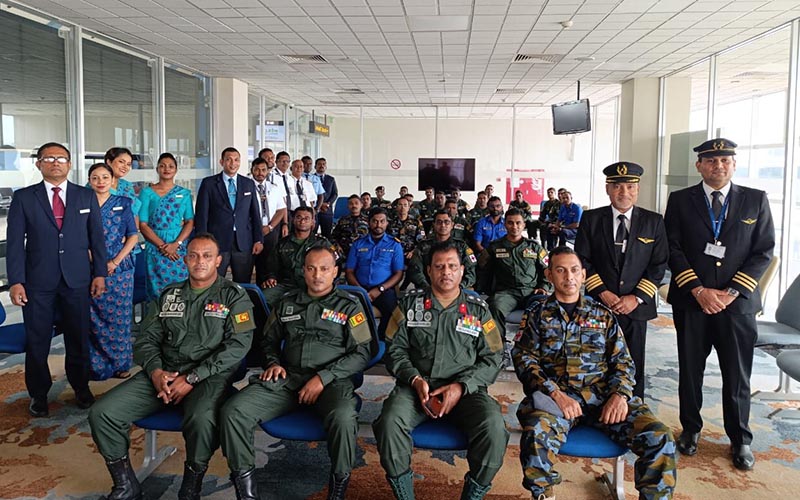
A specialized medical and disaster relief team, consisting of 26 members from the Sri Lanka tri-services led by Brigadier Punya Karunathilake, has departed for Myanmar on a special flight on Saturday (April 5), to assist those affected by the recent earthquake.
The disaster relief operation is being conducted under the supervision of Secretary to the Ministry of Defence, Air Vice Marshal Sampath Thuyacontha (Retd), following directives from President Anura Kumara Disanayake. It is noteworthy that the tri-service Commanders promptly mobilized the special relief teams within a very short time frame.
Myanmar, a Buddhist nation that has significantly contributed to the re-establishment of Theravada Buddhism in Sri Lanka, is receiving not only disaster and humanitarian aid from Sri Lanka, but also essential supplies The supplies were donated and collected by the people of Sri Lanka nationwide, under the guidance of the Venerable Maha Sangha, led by the Chief Prelates of the three Buddhist chapters, and are being sent to the Myanmar government.
Business
President and Indian PM jointly launch and inaugurate three development projects

The inauguration and commencement of three development projects implemented in the country with the assistance of the Indian Government took place on Saturday (05)
These projects include the commencement of construction of the Sampur Solar Power Plant, which will add 50 megawatts to the national grid, the inauguration of the Temperature and Humidity Controlled Agro Cold Storage complex in Dambulla and the installation of solar panels on 5,000 religious sites. President Anura Kumara Disanayake and Prime Minister Shri Narendra Modi jointly inaugurated and launched these projects via virtual technology following their official meeting at the Presidential Secretariat on Saturday morning.
Prime Minister Modi’s visit to Sri Lanka reaffirms the concept of “Friendship of Centuries, Commitment to a Prosperous Future,” strengthening the deep-rooted ties between the two nations.
The Sampur Solar Power Plant is part of the Eastern Renewable Energy Zone, which is being established under Sri Lanka’s Long-Term Generation Expansion Plan (LTGEP). It is being developed by Trincomalee Power Company, a joint venture between India’s NTPC Limited and the Ceylon Electricity Board (CEB).
The project is planned in two phases, with the second phase scheduled to commence in 2027. A 500-acre land area has been allocated for this initiative, under the first phase it will contribute 50 megawatts of electricity to the national grid. The project will incorporate state-of-the-art N-type TOPCon solar cell technology, enhancing energy security and promoting a shift from fossil fuel dependency to renewable energy sources. Consequently, the Sampur Solar Power Project is expected to reduce annual carbon dioxide emissions by approximately 200,000 tonnes.
The Dambulla Agricultural Storage Complex (Cold Storage Facility), with a capacity of 5,000 metric tons and equipped with temperature and humidity control, was inaugurated today with the objective of reducing post-harvest losses by approximately 40%, stabilizing fluctuations in agricultural product prices, ensuring the supply of high-quality food to consumers and enhancing agricultural sustainability.
To facilitate research on advanced storage methods for different crops, the facility includes six storage chambers, each designed to simulate various climatic conditions. This is the first facility of its kind in Sri Lanka, built at a total cost of LKR 524 million, with LKR 300 million provided as a grant by the Government of India and LKR 224 million contributed by the Government of Sri Lanka.
The Government of India has invested USD 17 million on the project to install solar panels on 5,000 religious sites and places of worship representing all major religions in all 25 districts. The nitiative, is being implemented jointly by the Ceylon Electricity Board, the Sri Lanka Sustainable Energy Authority and Lanka Electricity Company (Pvt) Ltd.
Under this project, 5,000 solar panel systems with a capacity of 5 kW each will be installed on the rooftops of Buddhist, Hindu, Muslim, Catholic and Christian places of worship. This is expected to add 25 megawatts of solar power capacity to the national electricity grid. The initiative underscores the government’s commitment to a cost-effective, sustainable and reliable energy system.
[PMD]
News
President confers Sri Lanka Mitra Vibhushana Award on Indian Prime Minister Shri Narendra Modi
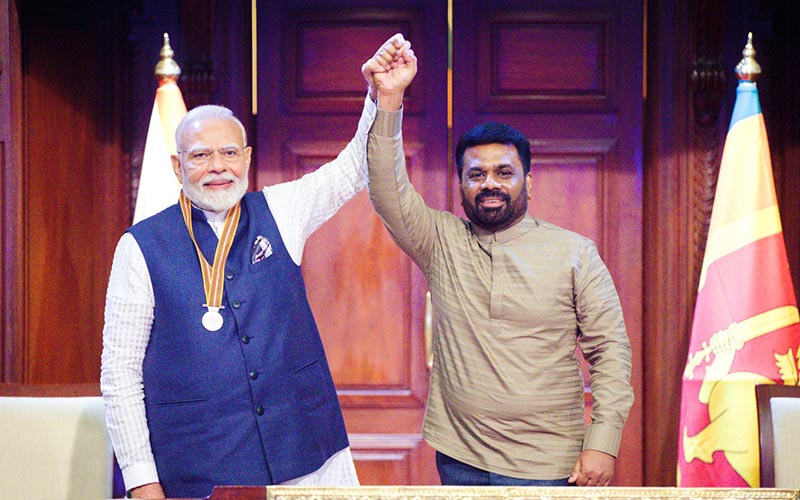
In appreciation of the enduring friendship and cooperation extended to the people of Sri Lanka, President Anura Kumara Disanayake conferred the prestigious Sri Lanka Mitra Vibhushana Award on Indian Prime Minister Shri Narendra Modi.
The President presented the award to Indian Prime Minister Shri Narendra Modi following an official meeting held on Saturday (05) at the Presidential Secretariat. The meeting took place as part of Prime Minister Modi’s state visit to Sri Lanka, undertaken at the invitation of President Anura Kumara Disanayake.
[PMD]
-

 Business2 days ago
Business2 days agoStrengthening SDG integration into provincial planning and development process
-

 News6 days ago
News6 days agoBid to include genocide allegation against Sri Lanka in Canada’s school curriculum thwarted
-

 Business1 day ago
Business1 day agoNew SL Sovereign Bonds win foreign investor confidence
-

 Sports3 days ago
Sports3 days agoTo play or not to play is Richmond’s decision
-

 Business1 day ago
Business1 day agoDaraz Sri Lanka ushers in the New Year with 4.4 Avurudu Wasi Pro Max – Sri Lanka’s biggest online Avurudu sale
-

 Latest News5 days ago
Latest News5 days agoIPL 2025: Rookies Ashwani and Rickelton lead Mumbai Indians to first win
-
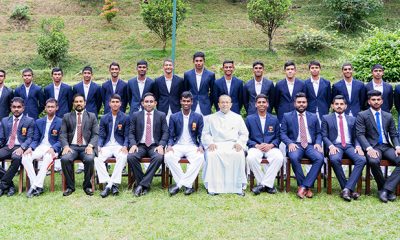
 Sports4 days ago
Sports4 days agoTrinity, St. Anthony’s out to end decade long victory drought
-
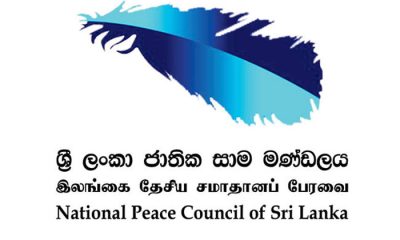
 News6 days ago
News6 days agoSL needs a comprehensive solution, not selective justice: NPC











